Chesapeake Community Modeling Program
CCMP Newsletter | January 2011
Volume 4, Issue 1
Introduction
Happy New Year! The CCMP newsletter is now entering it's fourth year of publication. We hope you continue to find this a useful resource for information on models, modelers, and all things open source. In this issue, our featured model is FVCOM and our featured modeler is Wen Long.
As always, if you have any comments or suggestions, please let us know!
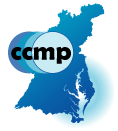
Contents
1. CCMP News in brief
2. Open Source on the March
3. Featured Modeler: Wen Long
4. Featured Model: FVCOM
5. Upcoming Meetings
1. CCMP News in Brief
Next generation Chesapeake Bay Model
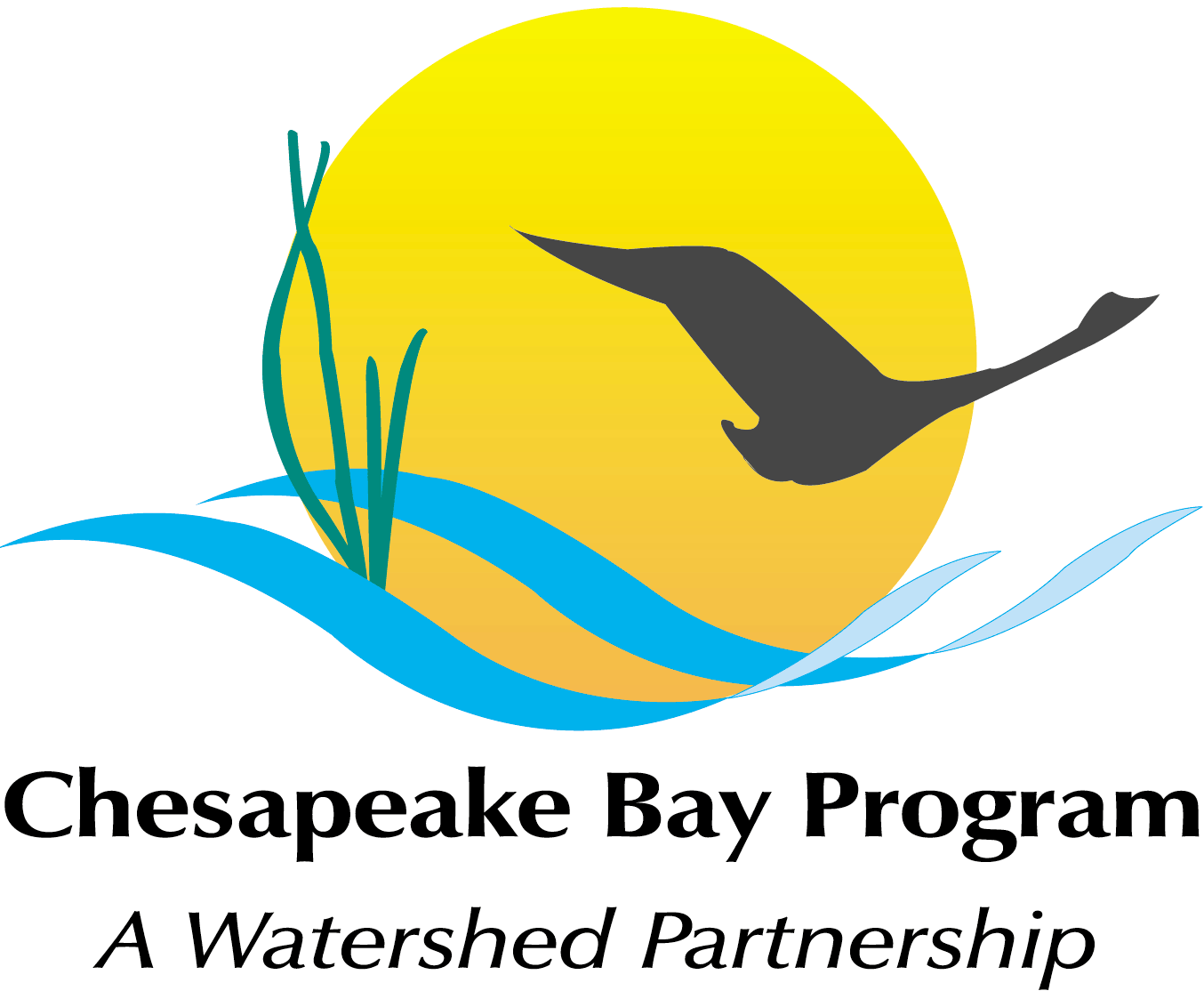 At the January 2011 Chesapeake Bay Program Modeling Sub-committee quarterly review, it was announced that by 2015 the CBP is expecting to have in place a fully operational next generation Chesapeake Bay Model. Some of the specifications for the new model include:
At the January 2011 Chesapeake Bay Program Modeling Sub-committee quarterly review, it was announced that by 2015 the CBP is expecting to have in place a fully operational next generation Chesapeake Bay Model. Some of the specifications for the new model include:
Dissolved Oxygen
- Full sediment diagenesis
- Finer grid to represent DO in shallow water and small embayments
- Explicit simulation of the adjacent coastal ocean
Chlorophyll – Primary Production
- Refined chlorophyll simulation and assessment
Living Resources
- Full simulation of filter feeders
- Estuarine Wetland simulation
Shallow Water SAV - Clarity
- Full sediment transport simulation with resuspension
- Refined simulation and assessment of SAV/Clarity
- Finer grid in shallow water and small embayments
- Representation of dredging and other activities that cause resuspention.
As a starting point, the CBP is reviewing alternative hydrodynamic models with a view toward replacing CH3D.
CCMP Chesapeake Hydrodynamic Model Workshop
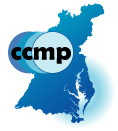 There has been a scheduling and venue change for the Hydrodynamic Model Workshop announced in the last CCMP newsletter. The workshop will now take place June 9 and 10, 2011 at the Smithsonian Environmental Research Center in Edgewater, MD. Attendees will hear presentations on the ROMS, FVCOM, EFDC, SELFE, ECOMSED, and ADH models and then discuss the merits of each as a replacement for the Bay Program’s current CH3D hydrodynamic model. Recommendations from the workshop will be developed into a white paper.
There has been a scheduling and venue change for the Hydrodynamic Model Workshop announced in the last CCMP newsletter. The workshop will now take place June 9 and 10, 2011 at the Smithsonian Environmental Research Center in Edgewater, MD. Attendees will hear presentations on the ROMS, FVCOM, EFDC, SELFE, ECOMSED, and ADH models and then discuss the merits of each as a replacement for the Bay Program’s current CH3D hydrodynamic model. Recommendations from the workshop will be developed into a white paper.
CSDMS Annual Report
 The CCMP partnered with the Community Surface Dynamic Modeling System (CSDMS) in 2009 to form CSDMS’s first geographically focused research group. CSDMS recently released it’s 2010 annual report. Some highlights from the report:
The CCMP partnered with the Community Surface Dynamic Modeling System (CSDMS) in 2009 to form CSDMS’s first geographically focused research group. CSDMS recently released it’s 2010 annual report. Some highlights from the report:
- 480 total members
- More than 160 open source models available registering 8000 downloads
- 1.5 million visits to CSDMS web-portal
- The model coupling tool (CMT) has been officially released
- Their first all-hands conference “Modeling for Environmental Change”
We wish CSDMS well as they begin their fifth year!
2. Open Source on the March
Random Hacks of Kindness
 In December 2010, a group of Software engineers and programmers met in 21 cities around the world for a weekend of hacking for a cause. This is the third such event where programmers use open source applications to develop solutions to help people in need around the world. From the rhok website:
In December 2010, a group of Software engineers and programmers met in 21 cities around the world for a weekend of hacking for a cause. This is the third such event where programmers use open source applications to develop solutions to help people in need around the world. From the rhok website:
“Random Hacks of Kindness: a community of developers, geeks and tech-savvy do-gooders around the world, working to develop software solutions that respond to the challenges facing humanity today.”
During a previous rhok event, an application was developed that picks up twitter feeds to identify crises hotspots. The application was then used in responding to the Haiti earthquake crises. Read more about this organization at http://www.rhok.org/
Open Source Climate Science?
In an online article (http://ourworld.unu.edu/en/could-climate-science-become-open-source) authors Brendan Barrett and Sulayman Sowe argue that the field of Climate Science could benefit from following an open source approach. They suggest that open source software methodology could be applied to climate science. The authors discuss how open source projects are governed by consensus and based on leadership by reputation. Making climate science open would make the process entirely transparent. The authors indicate that what they are suggesting is not without precedent as researchers at CERN currently follow an open source model. They are not suggesting a radical shift to an open source model but for incremental change towards that goal, which they acknowledge would still be difficult. For an institution like the IPCC, which is under constant scrutiny, it is difficult to be innovative. Barrett and Sowe suggest that the IPCC might start by choosing a specific topic and developing an experimental workgroup that has the mandate of using an open science approach.
Reading Barrett and Sowe’s article, one can’t help but think of what they are proposing in the context of Chesapeake science. One of the goals of CCMP is to promote the development and use of open source models in the Chesapeake Region. Anyone with an interest can now go to the CCMP website and download and use the same watershed model and data used by the Chesapeake Bay Program. Searching through the CBP website, you can find links to presentations, meeting minutes, data, methods, models and documentation. Clearly, the Bay Program is making an effort towards open science and management. Is the scientific community falling short by not responding to this openness by taking what the Bay Program has done and developing it further? On the other hand, if the scientific community did this, how would be the CBP respond and manage this input?
Integrated Environmental Modeling
The International Summit for Integrated Environmental Modeling was held December 7 - 9, 2010 at the USGS headquarters in Reston, VA. Representatives from 25 national and international agencies and organization participated in the three day summit with the goal of characterizing the current Integrated Environmental Modeling (IEM) landscape and developing a roadmap that will guide the future development and implementation of IEM systems.
Coming out of the summit, participants have a framework that will be developed into a roadmap and have identified several projects that they will complete over the next 12-18 months. You can track their progress on the iemHUB.
3. Featured Modeler: Wen Long
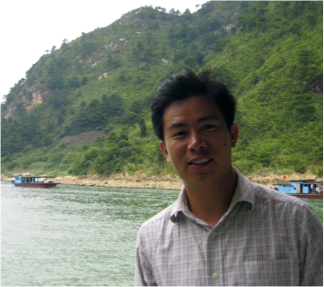 Horn Point Laboratory
Horn Point Laboratory
University of Maryland Center for Environmental Science
P.O. Box 775
Cambridge, MD 21613
Education:
- 1997 B.S., Tianjin University, China, Engineering Mechanics and Electrical Engineering
- 2000 M.S., Tianjin University, China, Engineering in Fluid Mechanics
- 2006 Ph.D., University of Delaware, Civil Engineering
Wen is an Assistant Research Scientist at Horn Point Laboratory where his research focus is on estuarine and coastal hydrodynamic and biogeochemical modeling. His areas of expertise also include nearshore wave and current modeling, sediment transport modeling, computational fluid dynamics and environmental fluid mechanics.
Wen’s current research projects include development and implementation of an operational physical/biogeochemical model of Chesapeake Bay (based upon ChesROMS which was featured in our June 2008 Newsletter ), development of a ROMS model for simulating larval transport and exchange between Chesapeake Bay, Delaware Bay and the coastal ocean (MACROMS), and participation in the SURA model intercomparison testbed (discussed in our August 2010 Newsletter ).
Wen has been working on modeling shallow and deep-water environments of the Delaware and Chesapeake Bays for more than 10 years, and he is an open-source pioneer in the Chesapeake Bay research community. Wen has collaborated with academic scientists from all around Chesapeake Bay to develop the ChesROMS modeling system. This state-of-the-art open-source model simulates temperature, salinity and circulation in Chesapeake Bay and it also includes water column and benthic biogeochemical cycling and sediment transport. Since 2007, all of the ChesROMS development has been done using a fully transparent, open-source approach with SourceForge (see http://sourceforge.net/projects/chesroms/) version control software. MACROMS has also been developed as an open-source model in SourceForge (see http://sourceforge.net/projects/macroms/) and Wen has spearheaded the development of Coastal Workspace, a bundle of open-source wave and sediment transport models based on his dissertation work (see http://sourceforge.net/projects/coastalspace/). Thanks to Wen, all of these models are freely available to anyone who wants to download and use them, and through SourceForge anyone can participate in their development as well.
Wen has also done ground-breaking work on developing a prototype operational implementation of ChesROMS, that involves automated streaming of real-time and forecast forcing data. This operational model has provided the foundation for the development of ecological forecasts for Sea Nettles, harmful algal blooms and pathogens in Chesapeake Bay
4. Featured Model: FVCOM - Finite Volume Coastal Ocean Model
Our featured model for this issue is the Unstructured Grid Finite Volume Coastal Ocean Model (FVCOM). It was developed at the Marine Ecosystem Dynamics Modeling Laboratory at the School for Marine Science and Technology, University of Massachusetts – Dartmouth. From the FVCOM website:
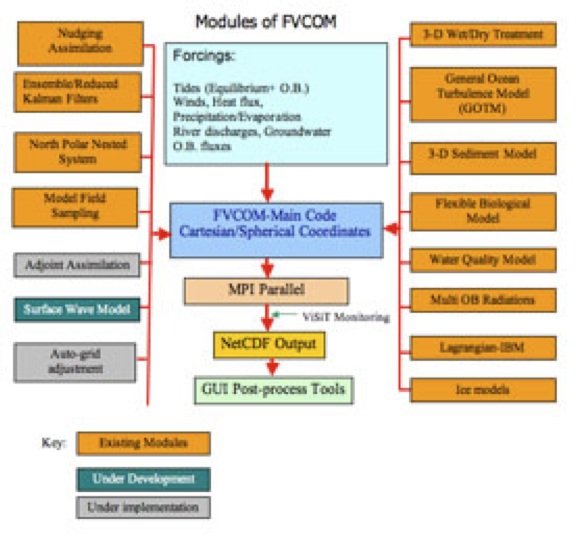 “The present version of FVCOM includes a number of options and components as shown in Figure above. These include (1) choice of Cartesian or spherical coordinate system, (2) a mass-conservative wet/dry point treatment for the flooding/drying process simulation, (3) the General Ocean Turbulent Model (GOTM) modules for optional vertical turbulent mixing schemes, (4) a water quality module to simulate dissolved oxygen and other environmental indicators, (5) 4-D nudging and Reduced/Ensemble Kalman Filters (implemented in collaboration with P. Rizzoli at MIT) for data assimilation, (6) fully-nonlinear ice models (implemented by F. Dupont), (7) a 3-D sediment transport module (based on the U.S.G.S. national sediment transport model) for estuarine and near-shore applications, and (8) a flexible biological module (FBM) for food web dynamics study. FBM includes seven groups: nutrients, autotrophy, heterotrophy, detritus, dissolved organic matter, bacteria, and other. With various pre-built functions and parameters for these groups, FBM allows users to either select a pre-built biological model (such as NPZ, NPZD, etc.) or to build their own biological model using the pre-defined pool of biological variables and parameterization functions. FVCOM was originally coded for sigma-coordinates in the vertical and now has been upgraded to a generalized terrian-following coordinate system with choices of various topographic-following coordinates. FVCOM is written in Fortran 90 with MPI parallelization, and runs efficiently on single and multi-processor machines.”
“The present version of FVCOM includes a number of options and components as shown in Figure above. These include (1) choice of Cartesian or spherical coordinate system, (2) a mass-conservative wet/dry point treatment for the flooding/drying process simulation, (3) the General Ocean Turbulent Model (GOTM) modules for optional vertical turbulent mixing schemes, (4) a water quality module to simulate dissolved oxygen and other environmental indicators, (5) 4-D nudging and Reduced/Ensemble Kalman Filters (implemented in collaboration with P. Rizzoli at MIT) for data assimilation, (6) fully-nonlinear ice models (implemented by F. Dupont), (7) a 3-D sediment transport module (based on the U.S.G.S. national sediment transport model) for estuarine and near-shore applications, and (8) a flexible biological module (FBM) for food web dynamics study. FBM includes seven groups: nutrients, autotrophy, heterotrophy, detritus, dissolved organic matter, bacteria, and other. With various pre-built functions and parameters for these groups, FBM allows users to either select a pre-built biological model (such as NPZ, NPZD, etc.) or to build their own biological model using the pre-defined pool of biological variables and parameterization functions. FVCOM was originally coded for sigma-coordinates in the vertical and now has been upgraded to a generalized terrian-following coordinate system with choices of various topographic-following coordinates. FVCOM is written in Fortran 90 with MPI parallelization, and runs efficiently on single and multi-processor machines.”
FVCOM is open source and is freely available for use in non-commercial academic research and education. It should be noted that the unstructured grid of this model is well suited to applications such as Chesapeake Bay with its intricate shoreline and complex geomorphology . The model is in use around the globe and has been applied in Nantucket Sound, South Atlantic Bight, Ogeechee River, South China Sea, Lake Superior , and the Arctic Ocean to name just a few regions. Current work is focused on the development of a Non-hydrostatic version as well as a Global version of FVCOM. For more information, visit http://fvcom.smast.umassd.edu/FVCOM/.
5. Upcoming Meetings
NCER 4th National Conference on Ecosystem Restoration 
August 1 – 5, 2011, Baltimore, MD - http://conference.ifas.ufl.edu/NCER2011/index.html
EMECS 9 Global Summit on Coastal Seas 
August 28 – 31, 2011, Baltimore, MD - http://www.conference.ifas.ufl.edu/EMECS9/
Integrated Modeling Workshop 2011
Integrated Modeling to Characterize Climate Change Impacts and Support Decision Making – February 1 – 2, 2011, Atlanta, GA - http://www.epa.gov/crem/2011climate.html
Chesapeake Community Model Program
http://ches.communitymodeling.org/
Chesapeake Research Consortium
Edgewater, MD
410-798-1283